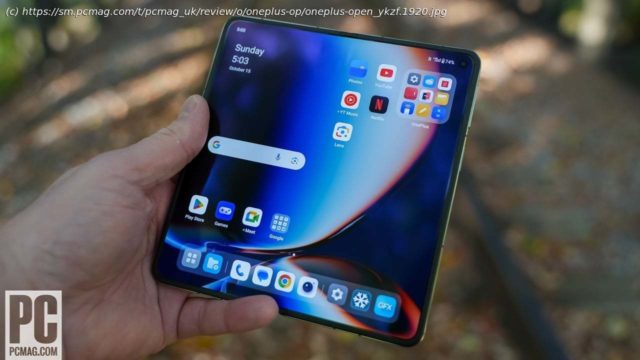A high-quality alternative to the Galaxy and Pixel Fold
The $1,699.99 OnePlus Open is the latest book-style folding phone to reach the US market, competing directly with the Google Pixel Fold ($1,799) and the market veteran Samsung Galaxy Z Fold 5 ($1,799.99). In order to stand out from its peers, OnePlus goes all-in on the design to create a usable device that splits the difference between the short-and-wide Pixel and the tall-and-narrow Z Fold 5. The company spent extra time refining its software to further differentiate itself; the phone has a fancy multitasking user interface that really lets you take control of open windows. Otherwise, its specs and features are pretty much on par with competitors. If you have the cash to spend on a book-style folding phone, the Galaxy Z Fold 5 remains our Editors’ Choice for its more polished experience, S Pen stylus support, and better battery life. But the OnePlus Open definitely heats up the competition.A Hingeworthy Design
OnePlus has always cared about design. If you’re familiar with the company’s design language, you’ll note how similar the Open is to the OnePlus 11 5G ($699). With the OnePlus Open, the company says it aimed to set a new bar for the folding form factor by using top materials and ensuring that the engineering behind the folding hinge mechanism is as durable as possible.
The company says it built the hinge around a single-spine architecture in order to make it sturdier while also reducing the number of parts and complexity. The Open’s hinge has 69 parts, in comparison with the more than 100 parts required by competing phones. The company also mixes up the materials, using a titanium alloy, carbon fiber, cobalt alloy, and zirconium-based metal. The effect is a hinge that’s stronger than stainless steel while also being lighter.
OnePlus claims the hinge is good for 1,000,000 folds, which amounts to 100 folds every day for 10 years (which is far longer than anyone will own the phone). Other foldables test to between 200,000 and 400,000 folds. There’s no question the hinge feels fluid and sturdy as you open and close the phone. It holds any angle you set, and unlike some phones, it folds completely flat when open.
The outer frame relies on aluminum. The flat metal band wraps around the edge of the phone and is a little sharp against your skin. Both outer panels are glass on the Emerald model, but switch to a mix of glass (front) and vegan leather (back) for the Voyager Black model. I prefer the Emerald model OnePlus sent us for review, which has a matte, micro-beaded texture to the material. The phone has an IPX4 rating, which means it is protected against light splashes, but not immersion. The Z Fold 5 and Pixel both have an IPX8 rating and can handle a dunk in water.
While the OnePlus Open is a sizable piece of hardware, it manages to be thinner and lighter than the competition. It measures 6.04 by 2.89 by 0.46 inches (HWD) when closed and 6.04 by 5.63 by 0.23 inches when opened. It weighs 8.43 ounces either way. The Z Fold 5 comes in at 6.10 by 2.64 by 0.53 inches closed and 6.10 by 5.11 by 0.24 inches folded, while the Pixel Fold measures 5.5 by 3.1 by 0.5 inches folded and 5.5 by 6.2 by 0.2 inches open. The Z Fold 5 weighs 8.9 ounces and the Pixel is a heavier 10 ounces.
The thinner profile and lighter weight of the Open really do help when carrying the phone around in your pants pocket. It’s noticeably more comfortable than the Z Fold 5 or the Pixel.
Controls, ports, and buttons are a typical lot. OnePlus was sure to put its popular ringer switch to work. The three-way switch, positioned near the top of the phone on the side, allows you to quickly set the phone to ring, vibrate, or silent. A large volume toggle makes adjusting the volume easy. The power button includes a built-in fingerprint reader, which was simple to train in testing, but only worked about 50% of the time. I resorted to using a PIN, which was often faster and more consistent than the fingerprint reader. You can use the front-facing camera to unlock the phone, but it’s not secure like Apple’s Face ID.
The USB-C port and SIM card tray are located on the bottom edge. The phone supports one physical SIM and one eSIM, but not memory cards of any kind. The phone’s two speakers are located on the top and bottom edges, as are several microphones.Double the Display
The primary benefit of a book-style folding phone is, of course, to have the biggest screen possible that will still fit in your pocket.
Let’s start with the outer display, which is what you’ll often interact with first. This LTPO Super Fluid AMOLED screen measures 6.31 inches across the diagonal with 2,484 by 1,116 pixels in a 20:9 aspect ratio for a density of 431ppi. OnePlus says the phone has a 91.8% screen-to-body ratio, meaning nearly all of the front face is taken up by the display. It pushes out an incredible 2,800 nits at peak brightness and has an adaptive 10Hz to 120Hz refresh rate for smooth movement. It’s protected by what OnePlus called Ceramic Guard, which it says is 20% more impact-resistant than Gorilla Glass Victus.
The outer screen of the Galaxy Z Fold 5, meanwhile, measures 6.2 inches with a resolution of 2,316 by 904 pixels in a narrow 23.1:9 aspect ratio and a 120Hz refresh rate. In contrast, the Pixel Fold’s 5.8-inch front OLED screen is shorter and wider with 2,092 by 1,080 pixels in a 17.4:9 aspect ratio at a density of 408ppi and a refresh rate of up to 120Hz. The OnePlus Open’s front screen has a size and shape that is most like those of today’s standard smartphones and is thus feels the most natural of the three.
The internal displays of the three foldables are more similar across the board. When you open the Open you’re greeted by a 7.82-inch LTPO Flexi-fluid AMOLED screen with 2,440 by 2,268 pixels at a density of 426ppi. It has a nearly square 1.08:1 aspect ratio, an 89.6% screen-to-body ratio, and a dynamic 1Hz to 120Hz refresh rate. It runs between 1,400 nits brightness (typical) and 2,800 nits (peak). The surface is protected by an ultra-thin flexible glass layer and has a touch response rate of up to 240Hz for gaming. The panel supports DCI-P3 and 10-bit color and is capable of playing back HDR10/HDR10+ content. It’s a phenomenal display that produces sharp text, rich video, and an excellent viewing experience indoors and out.
Oh, and the mid-screen crease is nearly nonexistent. The OnePlus Open has the least noticeable crease of any book-style foldable I’ve seen.
By way of comparison, the Z Fold 5 has a 7.6-inch inner screen with 2,176 by 1,812 pixels in a 4:3 aspect ratio and 120Hz refresh rate. It peaks at 1,750 nits. The Pixel Fold’s inner screen measures 7.6 inches with 2,208 by 1,840 pixels in a 6:5 aspect ratio and the same 120Hz refresh rate. All three screens have noticeable raised bezels that aid with grip when holding the phone open. The OnePlus Open’s bezels are the most refined, while the Pixel’s are the thickest and most obvious.OxygenOS With a Side of Open Canvas
Foldables need some special love and attention when it comes to software. The dynamic between the outer and inner displays requires finessing, and adapting apps and the user interface to the larger screen is an ongoing effort between Google and its hardware partners like OnePlus.
At a high level, the OnePlus Open ships with OxygenOS 13.2, which is based on Android 13. Oneplus says the phone will get Android 14 by the end of the year, but didn’t detail what, if anything, will be different in OxygenOS 14. Beyond that, the phone will get four years of Android OS upgrades and five years of security updates, which is solid but falls behind Google’s new seven-year commitment to its Pixel phones.
The external screen works just like any regular Android phone, fitting four apps/shortcuts across. Thanks to its full size and shape, it accommodates nearly all apps the way all Android devices do. You can control whether or not there’s an app drawer, set up multiple home screens, take advantage of wallpaper themes, load it up with apps and widgets, and so on.






